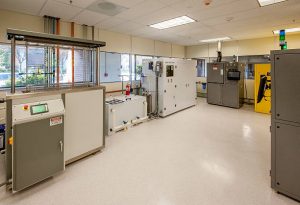In this article, we will learn how to safeguard laboratory environments and explore the significance of laboratory ventilation and the critical role of fume hoods in safeguarding laboratory environments. We will also discuss the different types of fume hoods and their applications, maintenance and safety guidelines, and why laboratories should prioritize a well-ventilated workspace.
At Simmyfranks West Africa Ltd, we understand the importance of maintaining safe and effective laboratory environments, and we provide solutions that cater to these needs.

Benefits Of Proper Laboratory Ventilation
Ventilation involves controlling the quality of air in the laboratory by removing contaminants, and fumes, and ensuring an adequate supply of fresh air. Proper ventilation serves several essential functions, including:
1. Protection from Hazardous Substances
It removes potentially harmful fumes and gases produced during experiments, protecting laboratory personnel.
2. Temperature Control
Maintaining a controlled temperature is critical for experiments that are sensitive to temperature changes.
3. Air Quality
Proper ventilation ensures that the air within the laboratory is free from contaminants, providing a safe and healthy environment.
4. Chemical Storage Safety
Adequate ventilation is crucial for laboratories with chemical storage areas, preventing the buildup of harmful vapors.
The Importance of Fume Hoods
Fume hoods are an integral part of laboratory safety and environmental control. These enclosed, ventilated devices are designed to capture, contain, and remove airborne contaminants produced during experiments, ensuring the safety of laboratory personnel. The benefits of fume hoods include:
1. Safety
Fume hoods protect researchers from exposure to hazardous chemicals and fumes, reducing the risk of accidents and exposure-related health issues.
2. Contamination Control
They prevent cross-contamination between experiments by effectively isolating each work area.
3. Environmental Protection
Fume hoods contribute to a cleaner laboratory environment by trapping and filtering harmful substances before release into the atmosphere.

Types of Fume Hoods and Their Applications
Laboratories may require various types of fume hoods to cater to different experiments and activities. Common types of fume hoods include:
1. Ducted Fume Hoods
These hoods are connected to an exhaust system that directs contaminated air outside the building. They are suitable for experiments involving volatile or toxic chemicals.
2. Ductless Fume Hoods
Ductless hoods filter and recirculate air, protecting without the need for external exhaust. They are suitable for certain applications and where external ducting is impractical.
3. Radioisotope Fume Hoods
These hoods are specially designed for handling radioactive materials and provide additional shielding to protect against radiation.
4. Perchloric Acid Fume Hoods
They are equipped with specific materials to resist the corrosive nature of perchloric acid, making them suitable for experiments involving this substance.
Selecting the appropriate type of fume hood depends on the laboratory’s activities and the nature of the experiments being conducted.
Maintenance and Safety Guidelines for Fume Hoods
Ensuring the proper functioning and safety of fume hoods requires adherence to a set of maintenance and safety guidelines:
- Regular Inspections: Schedule routine inspections to check for any damage or wear and tear.
- Verification of Airflow: Verify that the fume hood’s airflow remains within the specified range to ensure the effective removal of contaminants.
- Periodic Certification: Periodic certification of fume hoods is necessary to validate their performance and compliance with safety standards.
- Safe Use and Handling: Train laboratory personnel in the safe use of fume hoods, including proper positioning of equipment, minimizing clutter, and using appropriate personal protective equipment (PPE).
- Emergency Procedures: Establish clear emergency procedures for incidents such as chemical spills or equipment malfunctions.
- Regular Maintenance: Schedule regular maintenance to keep the fume hood’s components, such as fans, filters, and sashes, in optimal condition.
How To Prioritize a Well-Ventilated Workspace
Laboratories are complex environments with diverse equipment, experiments, and personnel. To safeguard laboratory environment and protect the well-being of those who work within it, it’s essential to prioritize proper ventilation and the use of fume hoods. Neglecting these aspects can lead to:
- Exposure to Harmful Substances: Failure to maintain a well-ventilated workspace can result in exposure to harmful fumes, chemicals, and particulates.
- Cross-Contamination: Inadequate control of contaminants can lead to cross-contamination between experiments, affecting the validity of research outcomes.
- Health Risks: Uncontrolled exposure to hazardous substances can result in acute or chronic health issues among laboratory personnel.
- Environmental Impact: Contaminants released into the atmosphere can harm the environment and may lead to regulatory compliance issues.

Safeguard Laboratory Environments With Simmyfranks
At Simmyfranks West Africa Ltd, we understand the critical role that proper ventilation and fume hoods play in maintaining safe and effective laboratory environments. We offer a range of laboratory equipment and solutions that are designed to enhance safety, accuracy, and efficiency. Our commitment to delivering quality products and comprehensive support ensures that laboratories can focus on their research and experimentation with confidence.
If you have any questions or require assistance with laboratory equipment selection or maintenance, please feel free to contact us. We’re here to support your laboratory’s commitment to safety and excellence





